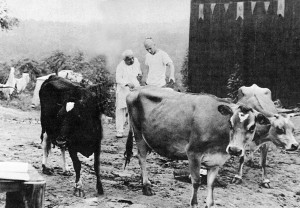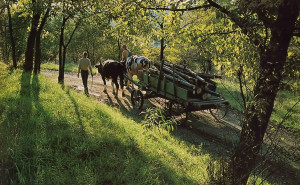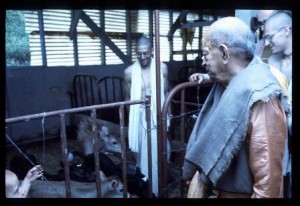
From Prabhupada’s Point of View: Alone in New York City
Websites from the ISKCON Universe
Gita verse-by-verse study Podcast
Download by “right-click and save content”
The post Gita 08.14 – What is difficult in one perspective is easy in another perspective appeared first on The Spiritual Scientist.
The post At Anna-Loka restaurant in Cardiff appeared first on SivaramaSwami.com.
Nimainanda, his wife Sucitra and his son Kunaal live in Auckland and attend New Varshana regularly. For a time Nimainanda lived on the farm and was the head cook.
Some years ago the family started “Gopal,” a business that supplies yoghurt, ghee, paneer and other products to grocery stores and now to supermarkets all over New Zealand.
By Krishna’s mercy, it has become very successful.
The post Dhanavira gives a mrdanga presentation appeared first on SivaramaSwami.com.
(Kadamba Kanana Swami, November 2015, Vrindavan, India, Video Interviews)
The essence is to consider the goal of life. When we think that sex is the goal of life, then sex is bad because then sex will be engaged in only on the basis of lust and day-by-day, we will become more and more bound up in material existence and in the suffering that the material world brings.
But when we understand that Krsna is the goal of life and we engage in sexual activities according to his direction, then we are engaging according to the injunctions of the Bhagavad-gita, in accordance with religious principles, as it is authorized by Krsna. Such sexual activity is very nice and purifying. So to say that sex is bad would not be true.

Prabhupada in New Vrindaban with Kaliya Cow 1976.
Written by Madhava Smullen. Archival Research by Chaitanya Mangala.
There’s no doubt that protecting cows was very close to Srila Prabhupada’s heart.
In a series of Back to Godhead magazine articles in the mid 1950s, he was already envisioning a community where residents lived a simple life and protected cows.
Soon after registering ISKCON in New York in 1966, he began requesting his disciples to start a rural community, asking them to call it “ISKCON-Nagari or New Vrindaban.”
And when Hayagriva Das, Kirtananda Swami and a handful of other devotees began New Vrindaban, ISKCON’s first farm, in 1968 in the hills of West Virginia, he urged them to keep cows and bulls there, and to maintain them comfortably throughout their natural lives as their proverbial mothers and fathers.
The cow’s milk could be used to create all kinds of staple foods, and their dung dried and used as fuel, he explained. Bulls could pull plows to till the ground for food grains. Together, they offered the chance of a peaceful, self-sufficient life free from the modern world’s stressful rat race and favorable for advancing in Krishna consciousness.
What’s more, he explained to Hayagriva in one of his first letters about New Vrindaban’s development, caring for cows was what Lord Krishna did every morning in Goloka Vrindavana. “Krishna by His practical example taught us to give all protection to the cows, and that should be the main business of New Vrindaban,” he said.
Prabhupada continued to write the New Vrindaban devotees nearly every month, espousing the benefits of cow protection along with outright entreaties for action.
“I am anxiously awaiting receipt of your first cow,” he wrote to Shyama Dasi in March 1969. And in April: “I hope you will soon be getting a cow for New Vrindaban. Vrindaban without cows does not look well, so we must have many cows as soon as possible.”

Kaliya the Cow New Vrindaban 1971
Devotees were glad to have finally purchased their first cow by the time Srila Prabhupada first visited New Vrindaban in May 1969. A black Jersey with a white mark on her forehead where Vaishnavas wear their tilak, she was named Kaliya, or “black,” by Prabhupada himself.
One of the first things the “Brijabasis” did when Prabhupada arrived was offer him a seat beneath a willow tree, and bring him fresh milk from Kaliya. They then sat around him in a semi-circle on the grass, looking up at him expectantly as he raised the cup to his lips.
Prabhupada was delighted. “I haven’t tasted milk like this in fifty years,” he said.
Excited at pleasing their spiritual master, the devotees brought Kaliya to meet him. Ranadhir Das paraded her before him, and Prabhupada admired her. “We don’t have such fatty cows in India,” he said. “In days past, yes, but now no one can feed them nicely. That is the way the Vedas calculate a man’s wealth—in cows and grains.” He even walked out to the barn to watch Ranadhir put Kaliya back in her stall.
During his visit, which lasted a whole month, Prabhupada continued encouraging the devotees, meeting with community leaders to discuss growing their herd from one to fifty. One cow’s milk could be shared by at least ten people, he said; or if each resident had their own cow, they could sell excess milk products and “get other necessities of life in that way.”
New Vrindaban and Kaliya stayed on Prabhupada’s mind after his visit. “I am always thinking of your New Vrindaban,” he wrote from Los Angeles just two days after leaving. “The first thing I find is the taste of the milk. The milk which we are taking here is not at all comparable with New Vrindaban milk.” He even offered to help finance more cows for the community.
Over the next few months and years, Prabhupada greatly enjoyed receiving in the mail curd cheese and milk sweets made from dairy provided by New Vrindaban’s protected cows; and he guided devotees in how to prepare them. “The whole idea of New Vrindaban is that men who are living there should produce their own food, of which milk is the principal thing,” he wrote.
After visiting New Vrindaban again in September 1972 to deliver a series of Bhagavat Dharma discourses, he was clearly enlivened by the progress he had seen. “I can see that Krishna is giving you more and more facility for developing this New Vrindaban scheme,” he said. “So this is very nice. I am very pleased that you have acquired some more cows.”
But he also cautioned the devotees not to forget about the bulls. “The cow is so wonderful and valuable in society,” he wrote. “But you should also use the bulls by engaging them in tilling the ground. People may call this the primitive way but it is very practical for engaging the bulls.”

Bulls 1976
By the time Prabhupada visited New Vrindaban again in July 1974, its cow protection program was thriving. There were 100 cows spread across three farms – Bahulaban, Vrindaban and Madhuban – including sixteen milking cows who produced over 600 gallons of milk per week. A fourth farm, Nandagram, housed young oxen, and three ox teams were being trained.
Prabhupada visited the Bahulaban barn, walking down its length and closely observing the cows on either side. He stopped at Shukla, whose milk he had also drank, and patted her on the head. He then observed the cow Satyabhama being milked, and when told that she was giving nine gallons daily said to cowherd Devakinandana Das, “You are doing wonderfully here.”
After his visit, Prabhupada wrote that he was “very happy” while in New Vrindaban and enjoyed the atmosphere, “especially the cow protection scheme.”
He continued to encourage the devotees to build a farm community that would set an example for how to treat cows: “Let other farms see… how we derive benefit from them and that will be the living example to persons who are using cow flesh rather than cow milk.”
In 1976, when he visited New Vrindaban for the last time, the community was caring for four working teams of oxen and over 150 cows. A new barn had been erected in Bahulaban, and Prabhupada visited it to see the cows and four new-born calves. He let one of them lick his hand as a devotee told him how the cows were yielding about 120 gallons of milk every day, which they were turning into ghee, cheese and buttermilk. Prabhupada was pleased.
But there was one cow he still hadn’t seen. Kaliya, now fourteen years old, was the retired matriarch of New Vrindaban’s herd. She had given birth to eight calves herself, and up until the previous year, had still been producing about six gallons of milk a day for the Lord and the devotees – despite having maladies common to aging cows of her breed, such as blindness in one eye and respiratory problems.
Writing in Brijbasi Spirit magazine, cowherd Amburish Das described how Kaliya – the smallest cow in New Vrindaban at 800 pounds – never pushed and shoved to eat grain as the other cows did, but stood patiently waiting her turn. “There may be some mild cows, but Mother Kaliya is even more than mild – she is a devotee,” he said. “Her humility is unmatched.”

Prabhupada Views Calves in New Vrindaban 1976
This rare soul was finally reunited with Srila Prabhupada after seven years in a meeting that left an indelible mark in the minds and hearts of those who witnessed it.
Towards the end of his visit, Prabhupada walked with a large group of devotees to go see Sri Sri Radha Vrindaban Nath in the farmhouse temple at the old Vrindaban farm, where Kaliya resided. It was a beautiful morning, the rays of the rising sun shining hazily through a light mist.
As Prabhupada rounded a curve and spotted the Vrindaban farmhouse in the distance, one of the devotees, Advaitacarya Das, pointed to a small herd of cows far up at the top of “Govardhana Hill,” which rose to their left. “Srila Prabhupada, look!” he said. “There’s Kaliya. She’s our first cow. You used to drink her milk.”
Suddenly, as Prabhupada looked up at her, Kaliya broke away from her herd and made her way alone down the steep bank. Matching the devotees’ pace, she stepped out right in front of Srila Prabhupada, and began walking with him as if she were his pet calf.
“Ah,” Srila Prabhupada said simply. “My dear old friend Kaliya.”
She continued to walk with him for some time, a quiet connection hanging between them that the devotees all felt. Then, finally Kaliya picked up her pace and disappeared over the horizon.
“For me, it was a mystical experience,” says Advaita. “Srila Prabhupada was always preaching that we’re all trying to get to Vrindavana, where Krishna and his cowherd boy friends are eternally playing and taking care of the cows. And to see Kaliya come down the hill and walk with him like that just made it all very real.”
After this last visit to New Vrindaban, Prabhupada continued to encourage his followers to establish cow protection programs all over the world. And to all of them, he gave New Vrindaban as the model farm community to emulate – the home of Kaliya, the “Queen of New Vrindaban,” and ISKCON’s very first cow.

Written by Madhava Smullen. Archival Research by Chaitanya Mangala.
There’s no doubt that protecting cows was very close to Srila Prabhupada’s heart.
In a series of Back to Godhead magazine articles in the mid 1950s, he was already envisioning a community where residents lived a simple life and protected cows.
Soon after registering ISKCON in New York in 1966, he began requesting his disciples to start a rural community, asking them to call it “ISKCON-Nagari or New Vrindaban.”
And when Hayagriva Das, Kirtananda Swami and a handful of other devotees began New Vrindaban, ISKCON’s first farm, in 1968 in the hills of West Virginia, he urged them to keep cows and bulls there, and to maintain them comfortably throughout their natural lives as their proverbial mothers and fathers.
The cow’s milk could be used to create all kinds of staple foods, and their dung dried and used as fuel, he explained. Bulls could pull plows to till the ground for food grains. Together, they offered the chance of a peaceful, self-sufficient life free from the modern world’s stressful rat race and favorable for advancing in Krishna consciousness.
What’s more, he explained to Hayagriva in one of his first letters about New Vrindaban’s development, caring for cows was what Lord Krishna did every morning in Goloka Vrindavana. “Krishna by His practical example taught us to give all protection to the cows, and that should be the main business of New Vrindaban,” he said.
Prabhupada continued to write the New Vrindaban devotees nearly every month, espousing the benefits of cow protection along with outright entrities for action.
“I am anxiously awaiting receipt of your first cow,” he wrote to Shyama Dasi in March 1969. And in April: “I hope you will soon be getting a cow for New Vrindaban. Vrindaban without cows does not look well, so we must have many cows as soon as possible.”
Devotees were glad to have finally purchased their first cow by the time Srila Prabhupada first visited New Vrindaban in May 1969. A black Jersey with a white mark on her forehead where Vaishnavas wear their tilak, she was named Kaliya, or “black,” by Prabhupada himself.
One of the first things the “Brijabasis” did when Prabhupada arrived was offer him a seat beneath a willow tree, and bring him fresh milk from Kaliya. They then sat around him in a semi-circle on the grass, looking up at him expectantly as he raised the cup to his lips.
Prabhupada was delighted. “I haven’t tasted milk like this in fifty years,” he said.
Excited at pleasing their spiritual master, the devotees brought Kaliya to meet him. Ranadhir Das paraded her before him, and Prabhupada admired her. “We don’t have such fatty cows in India,” he said. “In days past, yes, but now no one can feed them nicely. That is the way the Vedas calculate a man’s wealth—in cows and grains.” He even walked out to the barn to watch Ranadhir put Kaliya back in her stall.
During his visit, which lasted a whole month, Prabhupada continued encouraging the devotees, meeting with community leaders to discuss growing their herd from one to fifty. One cow’s milk could be shared by at least ten people, he said; or if each resident had their own cow, they could sell excess milk products and “get other necessities of life in that way.”
New Vrindaban and Kaliya stayed on Prabhupada’s mind after his visit. “I am always thinking of your New Vrindaban,” he wrote from Los Angeles just two days after leaving. “The first thing I find is the taste of the milk. The milk which we are taking here is not at all comparable with New Vrindaban milk.” He even offered to help finance more cows for the community.
Over the next few months and years, Prabhupada greatly enjoyed receiving in the mail curd cheese and milk sweets made from dairy provided by New Vrindaban’s protected cows; and he guided devotees in how to prepare them. “The whole idea of New Vrindaban is that men who are living there should produce their own food, of which milk is the principal thing,” he wrote.
After visiting New Vrindaban again in September 1972 to deliver a series of Bhagavat Dharma discourses, he was clearly enlivened by the progress he had seen. “I can see that Krishna is giving you more and more facility for developing this New Vrindaban scheme,” he said. “So this is very nice. I am very pleased that you have acquired some more cows.”
But he also cautioned the devotees not to forget about the bulls. “The cow is so wonderful and valuable in society,” he wrote. “But you should also use the bulls by engaging them in tilling the ground. People may call this the primitive way but it is very practical for engaging the bulls.”
By the time Prabhupada visited New Vrindaban again in July 1974, its cow protection program was thriving. There were 100 cows spread across three farms – Bahulaban, Vrindaban and Madhuban – including sixteen milking cows who produced over 600 gallons of milk per week. A fourth farm, Nandagram, housed young oxen, and three ox teams were being trained.
Prabhupada visited the Bahulaban barn, walking down its length and closely observing the cows on either side. He stopped at Shukla, whose milk he had also drank, and patted her on the head. He then observed the cow Satyabhama being milked, and when told that she was giving nine gallons daily said to cowherd Devakinandana Das, “You are doing wonderfully here.”
After his visit, Prabhupada wrote that he was “very happy” while in New Vrindaban and enjoyed the atmosphere, “especially the cow protection scheme.”
He continued to encourage the devotees to build a farm community that would set an example for how to treat cows: “Let other farms see… how we derive benefit from them and that will be the living example to persons who are using cow flesh rather than cow milk.”
In 1976, when he visited New Vrindaban for the last time, the community was caring for four working teams of oxen and over 150 cows. A new barn had been erected in Bahulaban, and Prabhupada visited it to see the cows and four new-born calves. He let one of them lick his hand as a devotee told him how the cows were yielding about 120 gallons of milk every day, which they were turning into ghee, cheese and buttermilk. Prabhupada was pleased.
But there was one cow he still hadn’t seen. Kaliya, now fourteen years old, was the retired matriarch of New Vrindaban’s herd. She had given birth to eight calves herself, and up until the previous year, had still been producing about six gallons of milk a day for the Lord and the devotees – despite having maladies common to aging cows of her breed, such as blindness in one eye and respiratory problems.
Writing in Brijbasi Spirit magazine, cowherd Amburish Das described how Kaliya – the smallest cow in New Vrindaban at 800 pounds – never pushed and shoved to eat grain as the other cows did, but stood patiently waiting her turn. “There may be some mild cows, but Mother Kaliya is even more than mild – she is a devotee,” he said. “Her humility is unmatched.”
This rare soul was finally reunited with Srila Prabhupada after seven years in a meeting that left an indelible mark in the minds and hearts of those who witnessed it.
Towards the end of his visit, Prabhupada walked with a large group of devotees to go see Sri Sri Radha Vrindaban Nath in the farmhouse temple at the old Vrindaban farm, where Kaliya resided. It was a beautiful morning, the rays of the rising sun shining hazily through a light mist.
As Prabhupada rounded a curve and spotted the Vrindaban farmhouse in the distance, one of the devotees, Advaitacarya Das, pointed to a small herd of cows far up at the top of “Govardhana Hill,” which rose to their left. “Srila Prabhupada, look!” he said. “There’s Kaliya. She’s our first cow. You used to drink her milk.”
Suddenly, as Prabhupada looked up at her, Kaliya broke away from her herd and made her way alone down the steep bank. Matching the devotees’ pace, she stepped out right in front of Srila Prabhupada, and began walking with him as if she were his pet calf.
“Ah,” Srila Prabhupada said simply. “My dear old friend Kaliya.”
She continued to walk with him for some time, a quiet connection hanging between them that the devotees all felt. Then, finally Kaliya picked up her pace and disappeared over the horizon.
“For me, it was a mystical experience,” says Advaita. “Srila Prabhupada was always preaching that we’re all trying to get to Vrindavana, where Krishna and his cowherd boy friends are eternally playing and taking care of the cows. And to see Kaliya come down the hill and walk with him like that just made it all very real.”
After this last visit to New Vrindaban, Prabhupada continued to encourage his followers to establish cow protection programs all over the world. And to all of them, he gave New Vrindaban as the model farm community to emulate – the home of Kaliya, the “Queen of New Vrindaban,” and ISKCON’s very first cow.

Taking Govardhana-Sila for a parikrama (Album with photos)
New Vraja-dhama under the snow, Hungary.
Srila Prabhupada: The letters of the holy name have so much spiritual potency that they act even when uttered improperly. (Sri Caitanya-caritamrta, Antya-lila, 3.59)
Find them here: https://goo.gl/quI7tH

Prabhupada in New Vrindaban with Kaliya Cow 1976.
Written by Madhava Smullen. Archival Research by Chaitanya Mangala.
There’s no doubt that protecting cows was very close to Srila Prabhupada’s heart.
In a series of Back to Godhead magazine articles in the mid 1950s, he was already envisioning a community where residents lived a simple life and protected cows.
Soon after registering ISKCON in New York in 1966, he began requesting his disciples to start a rural community, asking them to call it “ISKCON-Nagari or New Vrindaban.”
And when Hayagriva Das, Kirtananda Swami and a handful of other devotees began New Vrindaban, ISKCON’s first farm, in 1968 in the hills of West Virginia, he urged them to keep cows and bulls there, and to maintain them comfortably throughout their natural lives as their proverbial mothers and fathers.
The cow’s milk could be used to create all kinds of staple foods, and their dung dried and used as fuel, he explained. Bulls could pull plows to till the ground for food grains. Together, they offered the chance of a peaceful, self-sufficient life free from the modern world’s stressful rat race and favorable for advancing in Krishna consciousness.
What’s more, he explained to Hayagriva in one of his first letters about New Vrindaban’s development, caring for cows was what Lord Krishna did every morning in Goloka Vrindavana. “Krishna by His practical example taught us to give all protection to the cows, and that should be the main business of New Vrindaban,” he said.
Prabhupada continued to write the New Vrindaban devotees nearly every month, espousing the benefits of cow protection along with outright entreaties for action.
“I am anxiously awaiting receipt of your first cow,” he wrote to Shyama Dasi in March 1969. And in April: “I hope you will soon be getting a cow for New Vrindaban. Vrindaban without cows does not look well, so we must have many cows as soon as possible.”

Kaliya the Cow New Vrindaban 1971
Devotees were glad to have finally purchased their first cow by the time Srila Prabhupada first visited New Vrindaban in May 1969. A black Jersey with a white mark on her forehead where Vaishnavas wear their tilak, she was named Kaliya, or “black,” by Prabhupada himself.
One of the first things the “Brijabasis” did when Prabhupada arrived was offer him a seat beneath a willow tree, and bring him fresh milk from Kaliya. They then sat around him in a semi-circle on the grass, looking up at him expectantly as he raised the cup to his lips.
Prabhupada was delighted. “I haven’t tasted milk like this in fifty years,” he said.
Excited at pleasing their spiritual master, the devotees brought Kaliya to meet him. Ranadhir Das paraded her before him, and Prabhupada admired her. “We don’t have such fatty cows in India,” he said. “In days past, yes, but now no one can feed them nicely. That is the way the Vedas calculate a man’s wealth—in cows and grains.” He even walked out to the barn to watch Ranadhir put Kaliya back in her stall.
During his visit, which lasted a whole month, Prabhupada continued encouraging the devotees, meeting with community leaders to discuss growing their herd from one to fifty. One cow’s milk could be shared by at least ten people, he said; or if each resident had their own cow, they could sell excess milk products and “get other necessities of life in that way.”
New Vrindaban and Kaliya stayed on Prabhupada’s mind after his visit. “I am always thinking of your New Vrindaban,” he wrote from Los Angeles just two days after leaving. “The first thing I find is the taste of the milk. The milk which we are taking here is not at all comparable with New Vrindaban milk.” He even offered to help finance more cows for the community.
Over the next few months and years, Prabhupada greatly enjoyed receiving in the mail curd cheese and milk sweets made from dairy provided by New Vrindaban’s protected cows; and he guided devotees in how to prepare them. “The whole idea of New Vrindaban is that men who are living there should produce their own food, of which milk is the principal thing,” he wrote.
After visiting New Vrindaban again in September 1972 to deliver a series of Bhagavat Dharma discourses, he was clearly enlivened by the progress he had seen. “I can see that Krishna is giving you more and more facility for developing this New Vrindaban scheme,” he said. “So this is very nice. I am very pleased that you have acquired some more cows.”
But he also cautioned the devotees not to forget about the bulls. “The cow is so wonderful and valuable in society,” he wrote. “But you should also use the bulls by engaging them in tilling the ground. People may call this the primitive way but it is very practical for engaging the bulls.”

Bulls 1976
By the time Prabhupada visited New Vrindaban again in July 1974, its cow protection program was thriving. There were 100 cows spread across three farms – Bahulaban, Vrindaban and Madhuban – including sixteen milking cows who produced over 600 gallons of milk per week. A fourth farm, Nandagram, housed young oxen, and three ox teams were being trained.
Prabhupada visited the Bahulaban barn, walking down its length and closely observing the cows on either side. He stopped at Shukla, whose milk he had also drank, and patted her on the head. He then observed the cow Satyabhama being milked, and when told that she was giving nine gallons daily said to cowherd Devakinandana Das, “You are doing wonderfully here.”
After his visit, Prabhupada wrote that he was “very happy” while in New Vrindaban and enjoyed the atmosphere, “especially the cow protection scheme.”
He continued to encourage the devotees to build a farm community that would set an example for how to treat cows: “Let other farms see… how we derive benefit from them and that will be the living example to persons who are using cow flesh rather than cow milk.”
In 1976, when he visited New Vrindaban for the last time, the community was caring for four working teams of oxen and over 150 cows. A new barn had been erected in Bahulaban, and Prabhupada visited it to see the cows and four new-born calves. He let one of them lick his hand as a devotee told him how the cows were yielding about 120 gallons of milk every day, which they were turning into ghee, cheese and buttermilk. Prabhupada was pleased.
But there was one cow he still hadn’t seen. Kaliya, now fourteen years old, was the retired matriarch of New Vrindaban’s herd. She had given birth to eight calves herself, and up until the previous year, had still been producing about six gallons of milk a day for the Lord and the devotees – despite having maladies common to aging cows of her breed, such as blindness in one eye and respiratory problems.
Writing in Brijbasi Spirit magazine, cowherd Amburish Das described how Kaliya – the smallest cow in New Vrindaban at 800 pounds – never pushed and shoved to eat grain as the other cows did, but stood patiently waiting her turn. “There may be some mild cows, but Mother Kaliya is even more than mild – she is a devotee,” he said. “Her humility is unmatched.”

Prabhupada Views Calves in New Vrindaban 1976
This rare soul was finally reunited with Srila Prabhupada after seven years in a meeting that left an indelible mark in the minds and hearts of those who witnessed it.
Towards the end of his visit, Prabhupada walked with a large group of devotees to go see Sri Sri Radha Vrindaban Nath in the farmhouse temple at the old Vrindaban farm, where Kaliya resided. It was a beautiful morning, the rays of the rising sun shining hazily through a light mist.
As Prabhupada rounded a curve and spotted the Vrindaban farmhouse in the distance, one of the devotees, Advaitacarya Das, pointed to a small herd of cows far up at the top of “Govardhana Hill,” which rose to their left. “Srila Prabhupada, look!” he said. “There’s Kaliya. She’s our first cow. You used to drink her milk.”
Suddenly, as Prabhupada looked up at her, Kaliya broke away from her herd and made her way alone down the steep bank. Matching the devotees’ pace, she stepped out right in front of Srila Prabhupada, and began walking with him as if she were his pet calf.
“Ah,” Srila Prabhupada said simply. “My dear old friend Kaliya.”
She continued to walk with him for some time, a quiet connection hanging between them that the devotees all felt. Then, finally Kaliya picked up her pace and disappeared over the horizon.
“For me, it was a mystical experience,” says Advaita. “Srila Prabhupada was always preaching that we’re all trying to get to Vrindavana, where Krishna and his cowherd boy friends are eternally playing and taking care of the cows. And to see Kaliya come down the hill and walk with him like that just made it all very real.”
After this last visit to New Vrindaban, Prabhupada continued to encourage his followers to establish cow protection programs all over the world. And to all of them, he gave New Vrindaban as the model farm community to emulate – the home of Kaliya, the “Queen of New Vrindaban,” and ISKCON’s very first cow.

Preaching in Surfers Paradise, Gold coast, Queensland, Australia.
Sundar Nitai Dasa: This year I have decided to continue a program, pioneered by previous Iskcon devotees, called “Ask a monk any question ”. One sits in a public place with a sign reading [Ask a monk any question ] and awaits any approaches from the public. One can also keep some of Srila Prabhupada’s books in case one wants to inquire further into the Krsna consciousness philosophy. I thought it would be inspiring to some if I posted the events daily as they unfold.
While taking prasadam in Govinda’s restaurant, i decided to put my sign on the table just in case anyone had any questions. After I finished two young ladies, who had been sitting behind me, came to the table and said,“Hello, do you mind if we take advantage of your offer to ask a question?” this was Karen ,a religion and science student from Norway. “Please do”, I said “take a seat”, “we were wondering if you ever feel negative emotions? and if so how do you deal with that ?” [The answer was very long and the conversation was very intricate and we spoke for a long time back and forth so to convey the whole conversation would be difficult .] But what I said basically,was “yes! I do feel negative emotions sometimes!, and I pray to God and it goes away! ”. “ But how do you know it is God ?”,said Karen and not just your imagination or some belief system ? have you seen God ?how can you be sure ?“. she asked frankly. I could see where this was going so I asked her ’‘Do you know how much one mango costs to buy in India right now on the market ?” She looked confused, Mango?,“I can guess!”.she offered. “Why guess?”, I said “when you can know for sure !” “Actually, that information is bouncing off your eardrums right now and right before your eyes right now, isn’t it? , via internet technology. Do you believe in WI-FI ?”,I asked with a smile. “Yes”, she said, interested to see where this was going. “If you want to see and experience the benefits of being connected to the WI-FI there is a process. Let us look at that. 1[ you have to hear about the wi-fi from those who are connected and experiencing the benefits of being connected. 2] then have a desire to be connected also. 3]find an authorized apple/android dealer and say,” I have heard that there is an invisible entity called WI-FI can you help to experience it, please?“. he will say ’'YES, SURE, NO PROBLEM COME WITH ME .’'no doubts. he will not say, maybe! perhaps! in the future, I will be able to help. if he does then you know you need to go else where. He may also say things like, you cannot eat meat in here, nor can you get high or have sex, just sit patiently until I am ready to see you..and you must obey and wait with FAITH to be seen by the” apple/android Guru. 4]then he may give you a handset, a manual and a sim card deal with free WI-FI included [or so he promises ] some basic instructions and say , make sure you follow the guidelines in the manual,if you have any questions don’t hesitate to come back we are always here to serve you ! . you should be able to experience the benefits of WI-FI soon ! Isn’t that usually how it goes?“ i asked . ’'Yeah! and ???” she prompted. “So the same steps /process is there if you want to see God ! 1]You admit you cannot see Him, but others can and are experiencing the benefits of being connected to Him ie; more peaceful, compassionate, understanding ,kind, happy and so on and so forth. 2] your inquisitive and want to know if He is real ?can I see Him? 3]Approach an authorized Guru and inquire. 4]He may give you a practical experiment to take with you, like a prayer or mantra and a book of guidelines to live by and in no time, you will be experiencing the benefits of being connected to God. So there is always a process of disproving /verifying a theory, but we must make the experiment. So I am doing the experiment and experiencing some of the benefits, and this helps me deal with negative emotions. you can also do the same! what is stopping you ?” Karen and Stephanie were impressed, they took Srila Prabhupada’s books and gave a donation. Karen said “This is the most amazing conversation I have had in a long time, thank you for spending time with us”. I was touched deeply by the exchange. All glories to Sri Guru and Sri Gauranga! All glories to Srila Prabhupada!
The post Cardiff kirtana evening appeared first on SivaramaSwami.com.
The post Varnasram series: Duty appeared first on SivaramaSwami.com.
The post Cardiff kirtana evening: Mantras are persons appeared first on SivaramaSwami.com.


By Indradyumna Swami
As part of ISKCON’s 50th year celebrations we are working with devotees in China to bring our festival tour there sometime this year.The following are 3 short promotional videos we are showing in China to generate interest in our culture, the festival and the personalities involved. We have already received positive feedback from various groups in the Land of the Red Dragon. May Srila Prabhupada be glorified throughout the 3 worlds!

Sudharma Devi: You are warmly invited to view this 10 minute video featuring quotes from Srila Prabhupada and comments by Ravindra Swarup dasa, Dr. Abhishek Ghosh, Dr. Larry Shim, Kalakanta dasa (acbsp) Visakha devi dasi (acbsp) and other disciples of Srila Prabhupada related to the topic of ISKCON Vaishnavi’s serving as diksa gurus. The topic will be discussed by the the NAEC in Houston next week and the GBC body during the Mayapur meetings in February.

“CHASING RHINOS WITH THE SWAMI” - Excerpt.
Shyamasundar Dasa: For the past one month I have been cloistered in Mumbai, editing the huge manuscript of “Chasing Rhinos With The Swami.” The work is going well, and within a couple more weeks, I should have all 20 chapters edited as much as I can do them. By mid-February I am hoping to have everything readied for lay-out and printing. The following is an excerpt from Chapter Two.
(Chapter Two, in SAN FRANCISCO:)
‘The Swami comes in. While everybody’s chanting he starts building the fire, and smoke begins to fill the room. The four of us sit on the floor opposite the fire from Swamiji, and it’s getting hotter by the second; I discard my coat and loosen the tie. Devotees are chanting on every side, edging closer to the flames to catch the Swami’s words. He motions for us to take a few grains of rice and throw them whenever he says, Sva-ha! “Sva-haaa!” and we toss the rice at HIM, four handfuls of rice all over his gleaming head and robes. Unfazed, the Swami shakes his head and points to the fire. Oh, rice goes in the fire. Slow, but we’re catching on.’
His accent was still quite thick in those days-or we just hadn’t
learned to hear him yet-and he’s asking for bananas? Someone hands us bananas and we start to peel them-no, no, the Swami gestures, put them in the fire. Man, then the smoke really starts pouring out: four bananas smoldering, everyone coughing, eyes watering-along with rice, lentils, flowers, grapes, flour and, yes, more butter, which Swami ladles profusely over the flames between rounds of cryptic Sanskrit slokas ending with
Sva-ha! None of this bothers the Swami at all. He chants on our beads, hands them back with our new names, which we don’t understand-(wait, I got that one, Harry-das, that’s Harvey)-and devotees come forward to tie our neck-beads on with a knot.
'Then the Swami says “Bo dun”, and we’re trying to figure out what he’s saying-Harry-das thinks he has it figured out and he rolls onto his knees, leans forward-so we do the same thing–and he blows on the fire. We all start blowing on the fire, hard as we can–a cloud of smoke flies in the Swami’s face, and his eyes get big as saucers.’
 By Kesava Krsna Dasa
By Kesava Krsna Dasa Many people in the world think they live only once. With only one life, how does this affect lives and society? How is a one-life concept going to affects ambitions, goals and outlook? There is one-life spirituality and multi-birth spirituality – which of these enable a full understanding of the soul, and why good or bad things happen? Is God to blame, or us? If there is no God, why do people lament the loss of loved ones if they are simply bags of chemicals? With only one life, there must be a rush to cram the maximum in enjoyment. Life is meant for enjoyment, but what kind? Is the ideal of life enjoyment in spiritual happiness or just to be a decent human being without the need for religion? With one life ahead, can any spiritual path or non-belief in God satisfy the self? Let us examine some outcomes of one-life limitations. Continue reading "If You Only Live Once
→ Dandavats"

TOVP: The fist column installed! (Album with photos)
Sadbhuja Das: A few days ago we were able to see the GRC column put to place on the TOVP windows. Today an additional piece was added, the capital.
In these images we have the TOVP team giving thumbs up for the beautiful column.
Find them here: https://goo.gl/5fro26

Iskcon Australia: Harinama at Byron Bay. Ekadashi bliss (Album with photos)
Srila Prabhupada: Even a faint light from the holy name of the Lord can eradicate all the reactions of sinful life. (Sri Caitanya-caritamrta, Antya-lila, 3.63)
Find them here: https://goo.gl/E7a0K3

Never-say-die Spirit of Yatra Devotees in Kothapeta Village.
Kothapeta was, once upon a time, a very beautiful village with lush green farms, full of overloaded large mango trees, cashew nut tree groves, hundreds of coconut and tal trees. But just in a decade it has transformed into a concrete jungle. There are at least 10 4-storeyed apartments. It is very difficult to identify it as a village though official documents recognize it so. Farmers sold their lands to contractors in return of huge paper money. This easy money has resulted in popping up of many liquor shops, rise in promiscuity, and appearance of several brothels in every nook and corner of the village. According to one police officer, 9 raids there were conducted on brothels last year. Besides this there are many more sinful activities which are going on but cannot be described here for the sake of decency and space.
To read the entire article click here: http://goo.gl/Ugnd1H

By Sri Krishna Purusottama Das
Dear Srila Prabhupada,
Please accept our humble obeisances. All glories to your divine grace!
Krishna says in Bhagavad Gita:
mattaḥ parataraṁ nānyat
kiñcid asti dhanañ-jaya
mayi sarvam idaṁ protaṁ
sūtre maṇi-gaṇā iva BG 7.7
Translation:
O conqueror of wealth, there is no truth superior to Me. Everything rests upon Me, as pearls are strung on a thread.
50 years ago, you set your foot here in America to introduce Krishna Consciousness to the western world and to show us how Krsna is the cause of everything. By your mercy, today, there are hundreds of temples including farm communities all over the world. There are tens of thousands of devotees chanting Hare Krishna every day, there are millions of books distributed throughout the world. You are the force behind everything just as the thread in a pearl necklace, uniting us together in Krsna’s service.
On your 50 years of arrival to America, many devotees offered various articles of worship. Today, Team ISV would like to offer the results of our Monthly Sankirtan Pearl Festival as an expression of our gratitude and love to you Srila Prabhupada!
It turned out to be another historic event, with ISV devotees distributing thousands of books throughout the Bay area and dispatching them to other parts of North America.
Book distribution occurred with much enthusiasm during practically all weekends of this MSF.
Books were distributed at several Hari Nama performances in Palo Alto and San Francisco.
Books were also distributed at different festivals like Govardhan Puja, Pumpkin festival, Cupertino Diwali mela, Pleasanton Diwali Mela, Green festival and Christmas in the park.
Devotees also distributed books at ICC, Store to Store Sankirtan, Door to Door Sankirtan, Corporate Sankirtan, Motel Gita Sankirtan, Weekday Sankirtan and Kids Sankirtan.
Special yagna was conducted on the day celebrating the Advent of Bhagavad Gita.
In all,
More than 200 devotees participated in book distribution
Team ISV distributed total of 33,553 books which includes:
13 CC sets
1,492 Mahabig books smashing the goal of 1000 Maha Big books
Team ISV distributed 24,359 Gita’s smashing the goal of 22,000 Gita’s.
Out of which 18,048 Bhagavad Gita’s were distributed by Motel Gita team.
Team ISV distributed 144 SB Sets smashing the goal of 80 SB sets.
Team ISV raised $217,003 in Laxmi way surpassing the previous year’s total of $150,000 dollars.
Overall we are pleased to report that we met our yearly goal of 10% increase in our BBT scores.
Here is the summary of this year 2015:
Team ISV distributed 346 Srimad Bhagavatam sets
108 CC sets
total of 454 sets smashing the goal of 415.
Team ISV distributed 39,148 Bhagavad Gita’s
Smartbox collection in total was $7,270 dollars .
Team ISV collected $342,018 in laxmi.
Our gratitude to the dedicated ISV sankirtan devotees have tirelessly worked hard to smash these goals. Our deep gratitude to His Grace Vaisesika Prabhu for inspiring us throughout the year! Our gratitude to HG Nirakula Mataji for continuously inspiring us.
We pray to the Lordships Sri Sri Radha Madan Mohan, Sriman Maha Prabhu, Sri Sri Laxmi Narasimha dev to shower their blessings upon team ISV so that we can continue to work together to show mercy to all the souls.
Sri Sri Radha Madan Mohan ki Jay!! Sriman Maha Prabhu ki Jay!! Sri Sri Laxmi Narasimha dev ki Jay!! Srila Prabhupada ki Jay!!
Yhs,
Sri Krishna Purusottama das
——————————
Youtube link
https://www.youtube.com/watch?v=S7TY6ZiMpNw
Photos Album

The filming and sound editing is all by filmworkstudios.com - Rajesh Hirani, scripting by Jay Shetty.
After the very small matinee show in Detroit, we drove over to the ISKCON temple. I was surprised to discover that it was “Fisher Mansion,” a veritable palace built by an auto-baron in the late 1920s. I found myself on a tour of the place, walking through decadent room after decedent room, with our devotee tour-guide (dressed in slacks and shirt) proudly pointing out the ridiculous price tags that would be hung on any and all of the lamps, couches, and light-switches.
I was mortified and asked Dhanurdhara Mahārāja, “What’s the purpose of this? It just seems to glorify some karmī and his materialism.”
“I have my own doubts about it,” he said.
That was a relief.
When the tour ended, Mahārāja asked for something we could all eat. They brought out cold food, which seemed to really bother him, and he called for someone in charge.
“These are important guests,” he said to the man in charge. “All you can bring is cold prasadam?”
The man apologized and Mahārāja continued, “Some of them are very confused by the tour of the mansion. Vic, go ahead and explain your doubts.”
“Well,” I said. “It just seems so materialistic.”
“Prabhupāda wanted us to buy this mansion,” the man explained, “to attract people to come hear about Krishna.”
“OK,” I replied, “but when they come they don’t hear about Krishna, they just hear about how expensive the lamps and couches are.”
“It’s yukta-vairagya,” the man said. “We can use everything in Krishna’s service. Even very fancy material things.”
“Yeah, but how is this being ‘used in Krishna’s service?’” I asked. “The tour doesn’t glorify Krishna, it glorifies excessive sense gratification and some materialistic auto-baron.”
“Yes, but this is Krishna’s temple,” the man explained. “The money people pay to tour the mansion pays for Krishna’s temple and feeds Krishna’s devotees. So they are doing devotional service, unknowingly. And during the tour they see the ballroom, which is really a temple – so they see Krishna on the altar, and they get prasādam, and hear recordings of Prabhupāda chanting Hare Krishna.”
“That must just weird people out,” I said. “They must feel like it’s a ‘bait and switch.’ They come to see a historic mansion, but wind up in a Hare Krishna temple halfway through it? It would be much better to convert the mansion into a Vedic museum. People would still be attracted to see the opulence, but it would be so much more legit.”
Dhanurdhara Mahārāja was definitely on my side in the debate, and that made me feel great. I felt that even if there was stuff in ISKCON that made me very uncomfortable, at least this Swāmī was cool and was on the same page as I was about most of it.
This is what I wrote in my diary:
The Detroit trip did not do wonders for my faith in the current structure of ISKCON, but I did gain a great deal of respect for Danerdar [sic] Maharaj. I think that the present ISKCON is not anywhere near perfect, but if it is being helped into the future by great devotees like Maharaj, then there is good hope and bright times ahead.
When we retired to individual rooms for the night, Ray and I went with the two Swami’s. Dhanurdhara Swāmī seemed proud of and happy with me. “You are a real Vṛndāvana devotee,” he said, “renounced and simple. You should come to Vṛndāvana in October. We will have the Vṛndāvana Institute for Higher Education. It’s perfect for people like you.”
– Excerpt from an early draft of
Train Wrecks and Transcendence:
A Collision of Hardcore and Hare Krishna
By Vraja Kishor [VrajaKishor.com]
The post Daily Darshan : January 7th, 2016 appeared first on Mayapur.com.

January 7. ISKCON 50 – S.Prabhupada Daily Meditations.
By Satsvarupa dasa Goswami.
Prabhupada, the Original Book Distributor. All book distribution came from the inspiration of Prabhupada. In fact, all the different kinds of book distribution were originally done by him. The library party distributed books to universities and libraries, but Prabhupada was the first to do that successfully. In New Delhi, he was also the first one to distribute Back to Godhead magazines in the streets and at the tea stalls; he also distributed his own books in the bookstores in Manhattan.
Read the entire article here: http://www.dandavats.com/?p=20490&page=4
Kirtan – 46th Anniversary Celebrations at Temple – 12.16.2015
Gita verse-by-verse study Podcast
Download by “right-click and save content”
The post Gita 08.13 – External recitation and internal recollection propel us to spiritual liberation appeared first on The Spiritual Scientist.